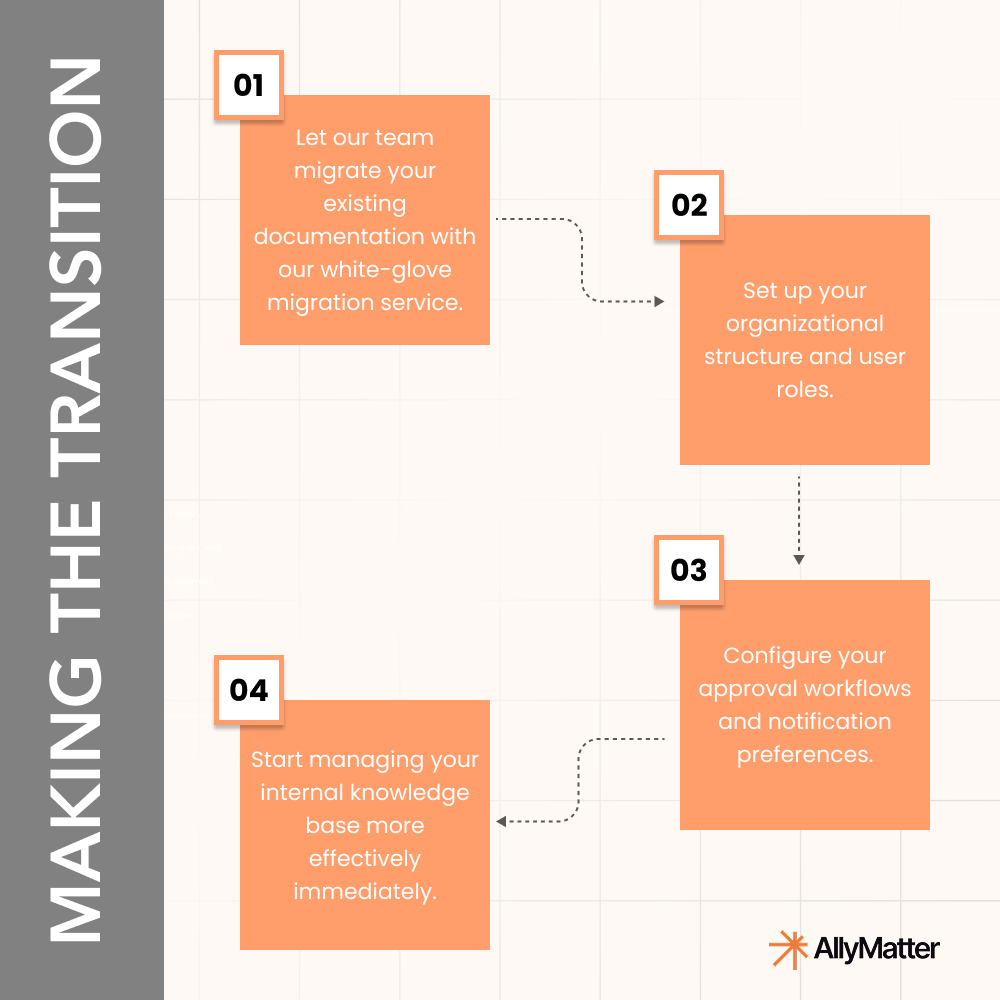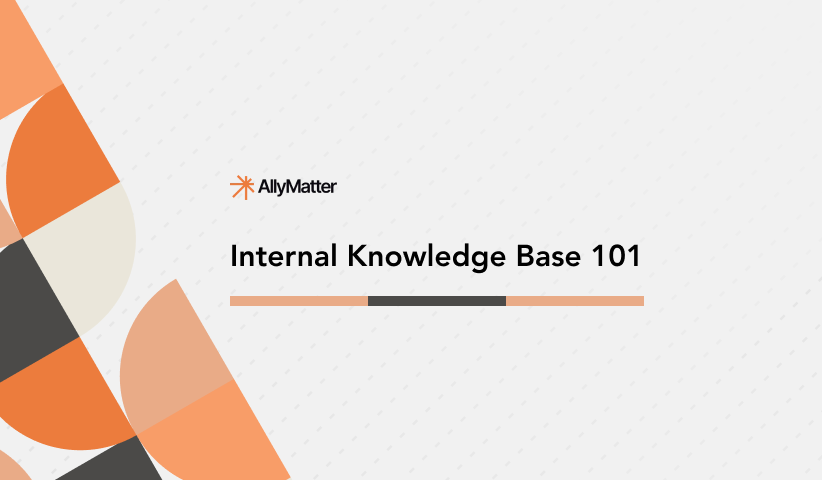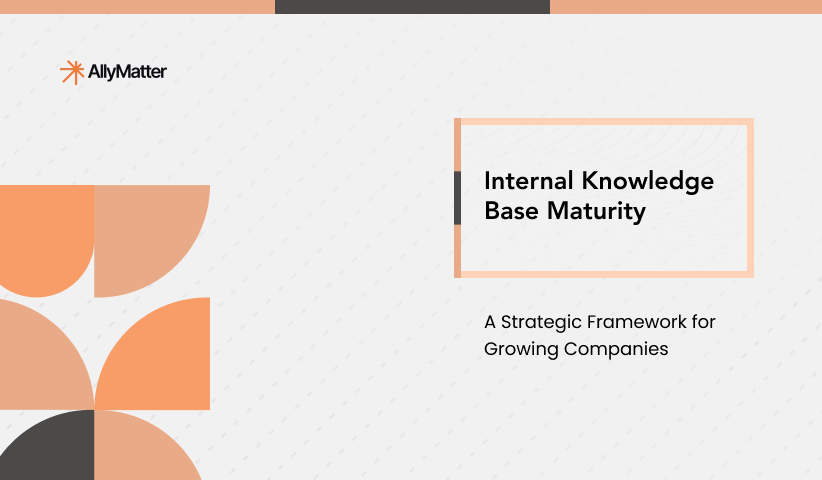You’ve just welcomed three new team members, and your company’s growth trajectory is exciting. But beneath the surface, a critical challenge is emerging – your internal knowledge base isn’t keeping pace with your expansion. Documents are scattered across drives, process information is buried in email threads, and your new hires are spending their first weeks just trying to figure out where everything is.
You’re not alone. While a well-organized internal knowledge base is the foundation of successful scaling, many fast-growing companies stumble when it comes to managing their documentation. In this post, we’ll explore the common challenges that can derail your growth and show you how to build a knowledge management system that supports rather than hinders your expansion.
The policy transformation minefield
When an employee moves from contractor to full-time status, an entire ecosystem of policies suddenly applies. What was once a narrow set of engagement terms expands to a comprehensive framework of organizational policies.
The contractor who previously followed project-specific guidelines now needs access to policies on paid time off, health insurance, retirement benefits, performance reviews, and internal conduct. Their intellectual property agreements shift from project-specific clauses to broader organizational protection.
This transformation creates a documentation challenge that intensifies with each new hire. Without a structured approach, you’ll find yourself reinventing the wheel with every status change, consuming hours that should be spent on strategic growth.
The document verification nightmare
Finding the right documents becomes a digital treasure hunt across disconnected systems. You dive into your HRMS platform, scroll through endless email threads, navigate folder mazes in Google Drive, explore SharePoint repositories, and send increasingly desperate messages to colleagues.
Each minute your team spends searching costs a minute of productive work. For growing companies, this inefficiency isn’t just frustrating; it’s a direct impediment to scale. When multiple team members spend hours weekly hunting for documents, you’re effectively paying a “disorganization tax” that compounds with each new hire.
The version control conundrum
Even after finding what you think is the right document, the questions multiply: Is this truly the latest policy version? When was it last reviewed? Did someone accidentally modify a critical section? Has legal actually approved this version?
Each system becomes a potential information black hole. You find multiple versions of the same document with no clear indication which is current. This uncertainty creates real business risk – from using outdated legal language to enforcing policies that no longer align with your company’s direction.
The communication and acknowledgment quagmire
The policy distribution dilemma
Even the most well-crafted policies fail if they don’t reach the right people at the right time. In fast-growing companies, critical updates get buried in overflowing inboxes or lost in chat threads. When your sales team can’t quickly find the latest pricing policy, or your support team is working from outdated customer service guidelines, the impact on your business is immediate and costly.
The signature collection nightmare
Collecting necessary signatures becomes a logistical marathon. Employees print documents, sign them, scan them, email them back – a process that can drag on for weeks. There’s no centralized tracking, no way to know where things stand without checking multiple sources. Each signature becomes a potential bottleneck in critical processes.
The permissions and access puzzle
Changing an employee’s status isn’t just about paperwork – it involves complex access management. IT teams must create new email addresses, recalibrate permission levels, and update systems. Each step involves different teams and different systems, with no central place to track completion.
This fragmented approach creates security risks and operational inefficiencies. New employees can’t access what they need, while former employees sometimes retain access they shouldn’t have. The resulting confusion creates both productivity drags and potential security breaches.
The compliance verification challenge
Ensuring compliance becomes increasingly difficult as you scale. Has every employee received the latest security policy? Can you prove that required training was completed? The process of verifying compliance across multiple systems becomes enormously time-consuming.
For growing companies facing their first audits or compliance reviews, this challenge can be particularly daunting. What should be a straightforward process of collecting existing records turns into weeks of reconstruction and last-minute policy creation.
The time and resource drain
What emerges is a process that’s simultaneously complex and inefficient. Hours are consumed by tasks that should take minutes. Multiple team members get pulled into verification efforts. Communication fragments across systems. The potential for errors multiplies with each manual step.
Employee transitions become less about welcoming new team members and more about surviving administrative obstacle courses. This inefficiency scales with your company – becoming exponentially more challenging as you grow.
Read: How Fast-Scaling Teams Handle Employee Transitions: A Guide
How AllyMatter solves these knowledge management challenges
AllyMatter wasn’t built just to store documents; it’s designed specifically to help fast-growing companies overcome these common knowledge management pitfalls. Here’s exactly how our platform addresses each challenge:
Unified document management
WYSIWYG editor with templates
Our intuitive editor includes pre-built templates for common documents, ensuring consistency and completeness. Each template includes suggested sections and sample language that you can customize for your needs.
Version control with change tracking
Every edit is tracked and highlighted, making it easy to see how documents evolve and ensuring clarity about what’s changed.
Smart document organization
Build structured, hierarchical documentation with clear categories and tags, helping employees find exactly what they need easily.
Stakeholder input and collaboration
Collaborative review workflows
Create custom approval flows involving multiple stakeholders, ensuring all relevant perspectives are captured before documents are finalized.
Comment and feedback system
Stakeholders can provide targeted feedback directly within documents, with threaded discussions to resolve questions or concerns.
Tag-based access control
Granular permissions ensure the right people are involved at the right stages of document development.
Effective communication and dissemination
Smart notifications
Automated alerts notify relevant team members when documents are updated, with confirmation tracking to ensure receipt.
Centralized access
A single source of truth for all documentation, accessible through an intuitive interface that works on any device.
Powerful search
Advanced search capabilities help employees find relevant information quickly, with filters for department, category, and status.
Training and education
Built-in acknowledgment system
Track who has read and acknowledged each document, with automated reminders for those who haven’t.
Version-specific training:
Link training materials directly to document versions, ensuring employees always have access to relevant guidance.
Regular reviews and updates
Automated review reminders
Set review schedules for documents, with automatic notifications when updates are due.
Impact analysis
Track which documents are most frequently accessed and where users might be struggling, helping you prioritize updates.
Change management tools
Set up structured processes for updating documentation, including approval workflows and automatic notification of affected employees.
Documentation and record-keeping
Comprehensive audit trail
Every interaction with a document is logged, from views to acknowledgments to approvals.
E-signature integration
It provides secure, legally-binding signatures for documents that require formal acknowledgment.
Automated compliance reports
Generate reports showing document distribution, acknowledgment rates, and review status – perfect for audits and compliance reviews.
Beyond features: The AllyMatter difference
While individual features are important, AllyMatter’s real value comes from how these capabilities work together to create a seamless knowledge management experience. Our platform is built for growing companies, with the flexibility to adapt as your needs evolve and the simplicity to get started quickly.
We understand that knowledge management isn’t just about documents; it’s about creating a foundation for sustainable growth. That’s why we’ve designed AllyMatter to be more than just a repository. It’s a dynamic system that helps you build and maintain the structure your growing organization needs.
Making the transition
Ready to transform your knowledge management? Getting started with AllyMatter is straightforward, and we’re here to help every step of the way.

Don’t let poor documentation management hold back your growth. Schedule a demo today to see how AllyMatter can help your organization scale with confidence.
Frequently asked questions about employee transition documentation
How do you maintain document accuracy during rapid scaling?
Implement version control systems with clear approval workflows. Assign document owners who are responsible for regular reviews and updates. Use automated notifications to alert teams when policies require revision, ensuring everyone works from current information.
What’s the best way to handle contractor-to-employee documentation transitions?
Create standardized transition checklists that outline all policy changes, access updates, and required signatures. Use a centralized platform where HR can track completion status and ensure no critical steps are missed during the status change process.
How can growing companies prevent knowledge loss during employee transitions?
Document all critical processes before they’re needed. Create detailed handover procedures, maintain updated organizational charts, and ensure knowledge is distributed across multiple team members rather than concentrated with individuals.
What security considerations apply when transitioning employee access?
Establish clear protocols for updating system permissions, revoking contractor access, and granting employee-level privileges. Maintain audit trails of all access changes and regularly review permissions to prevent security gaps during transitions.
How do you measure the effectiveness of transition documentation?
Track metrics like time-to-productivity for new hires, frequency of documentation requests, and employee feedback on information accessibility. Monitor audit compliance rates and document usage analytics to identify areas needing improvement.


